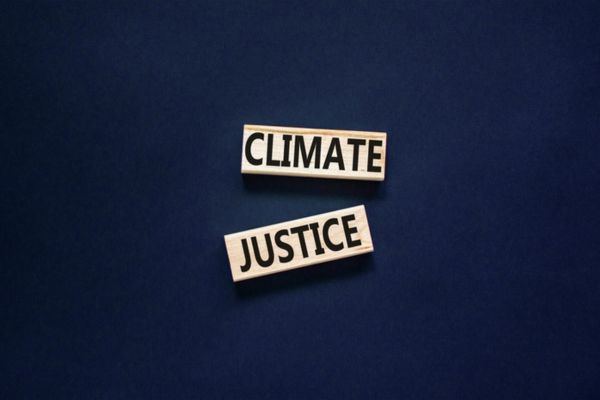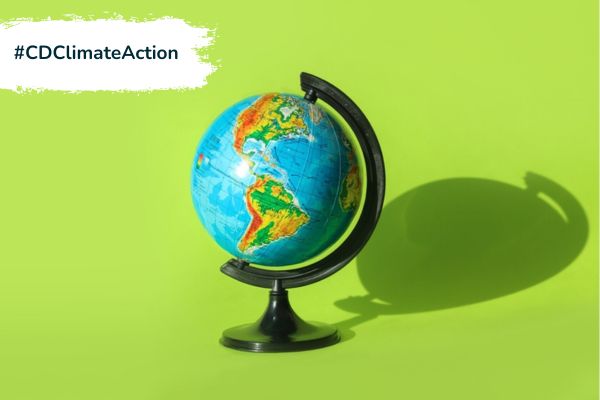Insights
INSIGHTS
All Topics
Climate change facts you need to know in 2024
We note the latest facts and stats about climate change, with reference to carbon emissions, net zero, global warming, biodiversity and wildlife, melting ice, ocean acidification, extreme weather patterns, climate finance, and much more
Check out the ’Climate Action’ hub!
Climate change is the most pressing issue of our time. Our Climate Action Campaign aims to tackle the climate crisis and help others to act ethically and efficiently.
We want to highlight, among other things, the importance of using digital to combat the crisis, tips and tricks to help you go green, how you can empower yourself and others, and how you can play a part in enacting change.
Knowledge is a tool for empowerment. Climate Action depends on effective decision-making, using the facts to inform our choices. An awareness of the science, an awareness of the extent of the change, an awareness of potential solutions, will all prove essential in the fight against climate change.
Awareness depends on gaining the right information, from respectable organisations, organisations committed to accuracy. We have compiled various facts about climate change, all secured from reputable and trusted organisations, using data from leading scientists and experts.
We hope the facts inform decisions, raise awareness, and help you tackle the climate crisis.
Skip to: General facts about climate change
Skip to: Facts about biodiversity and wildlife
Skip to: Facts about climate impact on oceans
Skip to: Facts about climate impact on ice and glaciers
Skip to: Facts about climate impact on weather
Skip to: Facts about future projections
Skip to: Facts about climate injustices
Skip to: Facts about climate and charities
Skip to: Facts about climate finance
Skip to: Facts about climate and digital
A quick definition on climate change
Let’s start with a quick definition of climate change. Simply put, the term climate change refers to long-term shifts in weather patterns and average temperatures.
Since the mid-1800s, humans have played a large role in releasing greenhouse gases into the air – largely through the use of oil, gas, and coal for homes, factories, and transport, as well as through modern farming methods and the cutting down of forests – which causes temperatures to rise.
Greenhouse gases, mostly carbon dioxide (CO2), trap the sun’s heat and cause the planet’s temperature to rise. Since the nineteenth century, the amount of CO2 in the atmosphere has increased by 50% and the world is currently between 1.0C and 1.2C warmer than it was in the late 1800s, depending on different trusted estimates.
A series of UN reports, produced by some of the world’s leading scientists, suggest that limiting global temperatures to a rise of no more than 1.5C would help us all avoid the worst impacts.
Based on projections, many of which we will explore in more detail below, and taking stock of current emissions and the current actions of individuals, nations, and international bodies across the world, the temperature of the climate will likely rise to around 3.2C by the end of the century.
But climate change is not simply about warming temperatures. It encompasses so much more. Our planet is complex and interconnected, with interdependent and fragile ecosystems, which means that even the smallest changes can have massive impacts, many of which we will highlight below.
General facts about climate change
General facts about climate change paint a picture of our current position. It shows that we occupy a world that has been affected by climate change. It shows, too, that we are not doing enough to change our course, to counter the main drivers of climate change. Below we cite some top-level facts about climate change, carbon emissions, greenhouse gases, and so on.
The world is getting hotter. According to the IPCC’s sixth assessment report on the state of our climate, the past decade is likely to have been the hottest period in the last 125,000 years. The IPCC assessment also concluded that 2016-20 was the hottest five-year period recorded since at least 1850.
Humans are the cause, without question. According to 350.org, rising temperatures correlate almost exactly with the release of greenhouse gases. It is not a coincidence. Scripps Institute of Oceanography provide a clear visual guide to that correlation, backed and substantiated by scientific study.
According to data published by NASA, CO2 is at its highest point in more than two million years. Pre-industrial CO2 levels were around 280 parts per million (PPM). In 2023, we are close to 420 PPM.
The last time the atmosphere contained as much CO2 as it does now, according to WIRED, was more than three million years ago, when sea levels were much higher and trees grew on the South Pole.
According to UN Climate Action, approximately 25% of the greenhouse gas emissions come from land clearing, crop production, and fertilisation, with animal-based food contributing the quarters of that number.
The need to address emissions from animal agriculture has become an increasing concern in recent years, largely due to added awareness from documentaries and climate literature. Adopting a more plant-based diet is often touted as a lifestyle change that can reduce personal emissions, though studies vary on the general extent of the impact.
Planting more trees has been cited as a potential solution. But relying on planting trees will not solve the problem of climate change. It will not even come close. To achieve net zero by planting tree to absorb carbon emissions,
According to Oxfam, would require 1.6 billion hectares of new forests, which is approximately five times the size of India, or more than all the farmland in the world.
Facts about climate, biodiversity, and wildlife
Protecting the planet means protecting life on the planet, protecting animals of all shapes and sizes, protecting plants and wildlife, protecting the nature that allows us to survive. But climate change has already had a destructive effect on our natural world and a failure to act meaningfully will ensure that continues. Below we look at some of the core facts around biodiversity and wildlife.
One of the toughest, and not often talked about, elements of climate change is extinction. The average size of vertebrate populations declined by 60% between 1970 and 2014, according to the biennial Living Planet Report published by the Zoological Society of London and the WWF.
An international panel of scientists, backed by the UN, have suggested that climate change plays an increasing role in driving species to extinction. Dozens of species of plants and animals go extinct each day – nearly 1,000 times the natural rate. By mid-century, as many as 30-50% of the species on Earth will have disappeared.
According to UN Climate Action, warming of 1.5C to 2C will cause most terrestrial species ranges to shrink dramatically. Changes in ranges can adversely affect species conservation, massively increase local species turnover, and substantially increase the risk of global extinctions.
There has been a 68% average decline in the population sizes of mammals, birds, amphibians, reptiles, and fish between 1970 and 2016, according WWF’s Living Planet Report 2020.
Extreme weather patterns, which we will discuss below, also adversely affect biodiversity and wildlife. In Australia at the end of 2019 and start of 2020, according to the Royal Society, fires made worse by climate destroyed 97 kilometres squared of forest and surrounding habitats.
Each year, according to the UN, more than 12 million hectares of land are lost to desertification, land degradation, and drought – a surface area equivalent to the entirety of arable land in Germany.
Human activity has significantly altered at least three-quarters of land-based environments – a number that continues to grow – and more than 66% of marine environments, according to the IPBES Global Assessment Report on Biodiversity and Ecosystem Services.
Facts about climate change and the impact on oceans
Oceans and bodies of water particularly feel the effects of climate change, many of them experiencing warming temperatures, acidification, coral bleaching, and other phenomena. Below we track some of the broad impacts felt by oceans and bodies of water due to climate change.
Let’s start with warming temperatures. According to a report from NASA, the ocean has absorbed much of the increased heat, with the top 100 meters of ocean warming more than 0.6 degrees Fahrenheit since 1969. The ocean, according to statistics provided by UN Climate Action, has absorbed roughly 90% of the heat generated by rising emissions.
A report from in PNAS shows that global sea levels rose by roughly 8 inches, or 20 centimeters, in the past century. But, importantly, the rate of increase over the past two decades is nearly double that of the past century – and that increase seems to accelerate with every passing year.
Data from the World Meteorological Organisation shows that global mean sea-level reached a new record high in 2021, rising an average of 4.5 millimetres per year from 2013-21.
Since the beginning of the industrial revolution, ocean acidity has increased by roughly 30%, according to the PMEL Carbon Program. Indeed, oceans have absorbed between 20% and 30% of the total anthropogenic carbon dioxide emissions in recent decades, which accounts for between 7.2 and 10.8 billion metric tons per year, according to a study on The Oceanic Sink published in Science.
Coral reefs are particularly vulnerable to climate change and are projected to decline to 10-30% of former cover at 1.5C warming and to less than 1% of former cover at 2C warming.
The Great Barrier Reef in Australia is estimated to have lost half its corals since the 1990s as a sustained rise in ocean temperatures bleached them white and made them uninviting to its colonising organisms, according to the International Union for Conservation of Nature.
Facts about climate change and the impact on ice and glaciers
It might seem obvious, but a warming planet drastically impacts a core part of our ecosystems: ice. The below stats track the loss of ice glaciers, show warming temperatures around ice sheets, and look at the retreats of ice glaciers around the world.
Data from NASA’s Gravity Recovery and Climate Experiment (GRACE) show that the country of Greenland lost an average of 279 billion tons of ice per year from 1993-2019, while Antarctica lost 148 billion tons of ice per year, broadly equivalent in weight to the rock that is Mount Everest.
A whopping 750 billion tons of ice is melting every year due to global warming, according to The World Counts. That means 24,000 tons of melting water being added to the world’s oceans every second.
According to the World Meteorological Organisation, since the mid-1980s, Arctic air temperatures have warmed at least twice as fast as the global average, while sea ice, the Greenland ice sheet, and ice glaciers have declined over the same period and permafrost temperatures have increased.
Ice glaciers are retreating elsewhere, including the Alps, Himalayas, Andes, Rockies, and in Africa and Alaska. Climate.gov has measured glacier change over time and noticed an increasing acceleration.
In the 2020 update to its Global Glacier Change Bulletin, representatives of the World Glacier Monitoring Service said that glaciers in its reference network lost more than 1.2 meters (3.9 feet) water equivalent in both the 2017/18 and 2018/19 water years.
Facts about climate change and the impact on weather patterns
Perhaps the most felt effect of climate change is shifts in weather patterns. We are witnessing increasingly unpredictable weather events, many of which can be directly attributed to climate change. Below we look at facts about changes to weather patterns, exploring impacts across the world.
According to Climate Science Special Report, extreme weather events are occurring much more often. Stats show that the number of high temperature events in the U.S. has increased and continue to increase, for example, and the number of low temperature events has decreased.
Carbon Brief gathered data from more than 200 different studies into “extreme event attribution” and found that 68% of extreme weather events studied in the past 20 years were made more likely or more severe by human-caused climate change.
The U.K. is not immune to extreme weather. In the summer of 2021, Greater London has seen 48% more rainfall than the city’s long-term average and increases of a similar scale have been recorded in Hampshire (up 49%), Surrey (up 54%) and West Sussex (up 52%), according to the Met Office.
2020 was the UK’s fifth wettest year since 1862, with 116% of the 1981–2010 average and 122% of the 1961–90 average rainfall, according to the International Journal of Climatology.
The Met Office issued its first ever amber heat warning for the UK in July 2021, and Northern Ireland broke its all-time temperature record on 21 July 2021, as the mercury soared to 31.3C at Castlederg.
The Lancet suggests that during the past 20 years there has been a 53·7% increase in heat-related mortality in people older than 65 years. That number, as the heat continues to rise, will increase.
The heat affects countries all across the world, without prejudice. The year 2020 saw record temperatures recorded in Belarus, Belgium, Estonia, Finland, France, Kazakhstan, Lithuania, Luxembourg, the Netherlands, Norway, Poland, Spain, Sweden, Switzerland, Ukraine, Japan, Mexico, Russia, and others, according to the National Centres for Environmental Information.
Many of those countries experienced temperatures that broke the 2020 record in 2021. And many countries experience temperatures that broke those records in 2022. And 2023, if projections are correct, will prove another record-breaking year of heat.
Wildfires, from Australia to Greece, are raging for longer and spreading farther than ever before, says the UN, which calculates that the blazes devastated roughly 30 million acres of land from 2018-20.
At least 155 million people were pushed into acute food insecurity in 2020 due to extreme weather, as well as conflict and economic shocks, says the World Food Programme.
Facts about future climate change projections
One of the key debates among climate scientists is not whether there is a problem – few scientists reject the notion of human-made climate change – but rather the extent of the problem. Here is a summary of key projections from reputable organisations.
According to the World Meteorological Organisation, the difference between necessary carbon dioxide reduction and current trends (otherwise known as the emissions gap), is estimated at 12-15 gigatons of CO2-equivalent, if we are to limit global warming to below 2C. For the 1.5C goal, the gap is 29-32 Gt CO2e, roughly comparable to the combined emissions of the six largest emitters.
The same report showed that to limit warming 1.5C, the world needs to decrease fossil fuel production by around 6% between 2020-30. Countries are instead projecting an average annual increase of 2%, which by 2030 would result in more than double the production consistent with the 1.5C limit.
Only 0.8% of the planet’s land surface has mean annual temperatures above 29C, mostly in the Sahara desert and Saudi Arabia. But a recent study called Future of the Human Niche found that by 2070, under a high emissions scenario, unbearable temperatures could expand to affect up to three billion people, meaning that many new places will become too hot to live by the end of the current century.
Despite noble efforts and campaigns, plastic production and use is forecast to double over the next 20 years and quadruple by the early 2050s, warns the Heinrich Böll Foundation. That’s a problem because, even disregarding the deleterious effects to biodiversity and wildlife, greenhouse gases such as CO2 and methane are released at every stage of plastic’s lifecycle, from production to consumption.
According to Earth.Org, on the world’s current trajectory, climate change could end up costing us 11-14% of the global gross domestic product (GDP) by mid-century. Regression into a high emissions scenario would mean an 18% cost, while staying below 2C would reduce the cost to only 4%.
Facts about climate change and injustices
Climate change affects people and communities disproportionately. Marginalised groups and vulnerable people are more likely to experience the impacts of climate change – and they are less likely to impact decision-making around climate change. Below we explore some facts around inequalities of climate change, looking particularly at gender and wealth at a personal and national level.
The World Bank’s 2021 Groundswell report found that climate change could force up to 216 million people to move within their countries by 2050.
200 million people in the world, more than three times the UK population, will live below the tideline by the end of this century if levels continue to rise, according to Nature Communications.
Migration decision-making in the face of climate risks disproportionately affects women, according to the UN, as they face increased barriers to leaving, such as the absence of financial assets, limited rights to land and property, and caregiving obligations.
A 2022 report from IPCC found that girls and women are at higher risk of food insecurity than boys and men, are more likely to die in extreme weather events, and are more likely to experience mental health impacts caused by climate change.
Women are undervalued in decision-making around climate change. Reports find that men fill approximately 67% of climate-related decision-making roles and women’s representation in national and global climate negotiating bodies remains below 30%.
The Generation Equality Action Coalition on Feminist Action for Climate Justice found that just 3% of philanthropic environmental funding supports girls’ and women’s environmental activism.
According to UN Women, extreme heat increases incidence of stillbirth and the effects of climate change increase the spread of vector-borne illnesses such as malaria, dengue fever, and Zika virus, which are all linked to life-threatening maternal and neonatal outcomes.
According to DARA’s Climate Vulnerability Report, more than 800 million people, or more than 11% of the global population, are currently vulnerable to climate change impacts such as droughts, floods, heat waves, extreme weather events, and so on. People living in parts of the world that are not impacted, often places responsible for the most emissions, do not face the same vulnerability.
Marginalised communities disproportionately face the impacts of climate change, such as health consequences, loss of electricity and heat and other amenities, and financial problems, according to Global Citizen. Climate change tends to interact with and worsen existing inequalities that already exist in our society, which highlights the need for an interactional approach to climate action.
According to UN Climate Action, the 100 least-emitting countries generate just 3% of total emissions, while the ten largest emitters contribute 68%, which shows that while everyone must take climate action, people and countries creating more of the problem hold a greater responsibility.
Between 1990-2015, the richest 1% of the world’s population were responsible for more than twice as much carbon emissions as the poorest 50% of humanity, according to Oxfam reports.
Oxfam also suggests that the estimated average carbon footprint of the world’s richest 1% could be up to 175 times larger than that of someone in the poorest 10%, showing that wealthier parties are disproportionately causing climate change yet are more easily able to escape its impacts.
Facts about climate change and charities
Charities play a leading role in raising awareness of climate impacts, building knowledge of climate science, and fighting back against climate change. Charities need to lead by example. We need to push forward and inspire others to change. Here are some facts around charities and climate change, along with a list of some of the charities fighting against climate change.
A Charity Commission report found that charities are increasingly recognising environmental concerns, but usually only as a result of pressure from key individuals. The report found that trustees are seldom the key drivers in implementing environmental initiatives.
The Charity Commission report also identified a range of practical, financial, and attitudinal barriers to environmental change, but such barriers were overcome with pressure from key people. The report also found that some charities (including seven of the top thirty charities) now incorporate an Environmental Statement in their Trustees’ Annual Report.
A report from The Lancet found that the number of work hours lost to heat across the globe increased from 199 billion in 2000 to 295 billion in 2020, equivalent to 88 work hours per employed person.
Here is a non-exhaustive list of just some of the charities currently acting on climate change:
- Cool Earth
- Clean Air Task Force
- Union of Concerned Scientists
- Carbon180
- Greenpeace
- Earth Justice
- Rainforest Alliance
- Climate Foundation
- Climate Emergency Fund
- Friends of the Earth
- Environmental Defense Fund
Click on the links to see how you can support, volunteer, or collaborate with any of the above.
Facts about climate change and climate finance
The rise of the eco-investor, the scrutiny on environmental, social, and governance (ESG) policies, and a greater transparency around organisational and personal investment means that we will talk about climate finance for many years to come. The below offers a snapshot of the current situation, looking at climate finance from a governmental, organisational, and individual perspective.
According to UN Climate Action, the $345 billion provided as global subsidies for fossil fuels results in $5 trillion in overall costs, including in terms of the deterioration of nature.
Finance should prioritise the most vulnerable people with the fewest resources to cope with climate hazards. The rate of return can be high. Early warning systems for disasters, according to the World Bank, save lives and property, and can deliver benefits up to 10 times the initial cost.
According to the Global Commission on Adaptation, a $1.8 trillion investment in warning systems, climate-resilient infrastructure, dryland agriculture, global mangrove protection, and resilient water resources could generate $7.1 trillion in avoided costs and social and environmental benefits.
Worldwide, only 38% of small firms have invested in adapting to environmental risks, compared to 60% of large firms, according to a report from the International Trade Centre.
Developed countries have agreed to provide $100 billion to developing countries each year. But based on the most recent assessment conducted by developed countries, the UN found that climate finance counting towards the $100 billion commitment continues to fall short, reaching $78.9 billion in 2018.
The combined global fiscal response to the pandemic was $18 trillion as of March 2021, according to a UN report called The Time to Act is Now. Applying the same decisiveness and the same willingness to act is vital in the fight against climate change.
Facts about climate change and digital
Investment in digital and high-tech solutions will prove essential in the climate crisis. That means both at a massive international level, and on a personal and organisational level to reduce your carbon footprint. Green tech is becoming increasingly important, as more and more people notice the environmental detriment of older (and some new) technologies. Below we consider some facts around digital and climate change, showing the challenges and the opportunities set to define the future.
According to a report by Ericsson, corroborated by the World Economic Forum, IT and tech equipment accounts for about 1.4% of total carbon emissions and uses about 3.6% of global electricity consumption, while making up around 6% of the global economy.
But the collective digital footprint might prove much larger. In fact, according to a 2019 study by the Shift Project, the world’s collective digital carbon footprint accounted for nearly 3.7% of all greenhouse emissions, which is comparable to aviation industry emission levels.
That might not seem too frightening. But consider that digital technology’s energy consumption increased by almost 70% between 2013 and 2020, according to the Shift Project. That means that future consumption for digital, if we don’t change, could prove catastrophic.
A study by the UK’s OVO Energy found that the UK could reduce its carbon output by over 16,433 tons, simply by each adult sending one less email per day. And the average CO2 consumption of streamed online videos, according to Shift Project, rose to around 300 million tons per year, the same as Spain.
If brought to scale, digital technologies could reduce emissions by 20% by 2050 in the three high-emitting sectors (energy, materials and mobility), according to WeForum. These industries can already reduce emissions by 4-10% by 2030 by accelerating the adoption of digital technologies.
Facebook’s 2.85 billion users each produce 12 grams of carbon dioxide annually by using the platform, according to information from Meta. The social media platform is one of the biggest consumers of energy on the planet – and other social media platforms are not far behind.
Data centres that mine for the cryptocurrency Bitcoin alone consumed up to 0.3% of the world’s electricity in 2019, as much as Belgium. But data centres worldwide consume about 2% of global electricity, a figure set to reach 8% by 2030, and nearly 1% of global emissions, according to the Institute of Economic Affairs.
But digital also provides solutions. On an organisational and personal level, Blockchain technology could allow concerned citizens to track corporate carbon emissions and digital technology could help reduce the world’s carbon emissions by about 17%, according to a report.
On a worldwide scale, according to a Global Commission on Adaptation report, solar-powered irrigation, weather alert systems, new crop varieties and other adaptive measures can help avoid a drop-off in global agricultural yields by up to 30% by 2050.
Sign up for our newsletter
Click above to receive the latest sustainability content straight to your inbox
Ioan Marc Jones
More on this topic
Related Content
Recommended Products
Recommended Products
17 May 2024by Ioan Marc Jones
A guide to mental health awareness
13 May 2024by Josie Sparling
Charity Spotlight: Lizzie Carr, Founder of Planet Patrol
Our Events
Webinar: A charity guide to Meta Quest VR
Join us on the 30th of May, where we will explain more about how VR technology works and how it can help charities, hearing from organisations where the technology has already made a difference.
We use cookies so we can provide you with the best online experience. By continuing to browse this site you are agreeing to our use of cookies. Click on the banner to find out more.









































